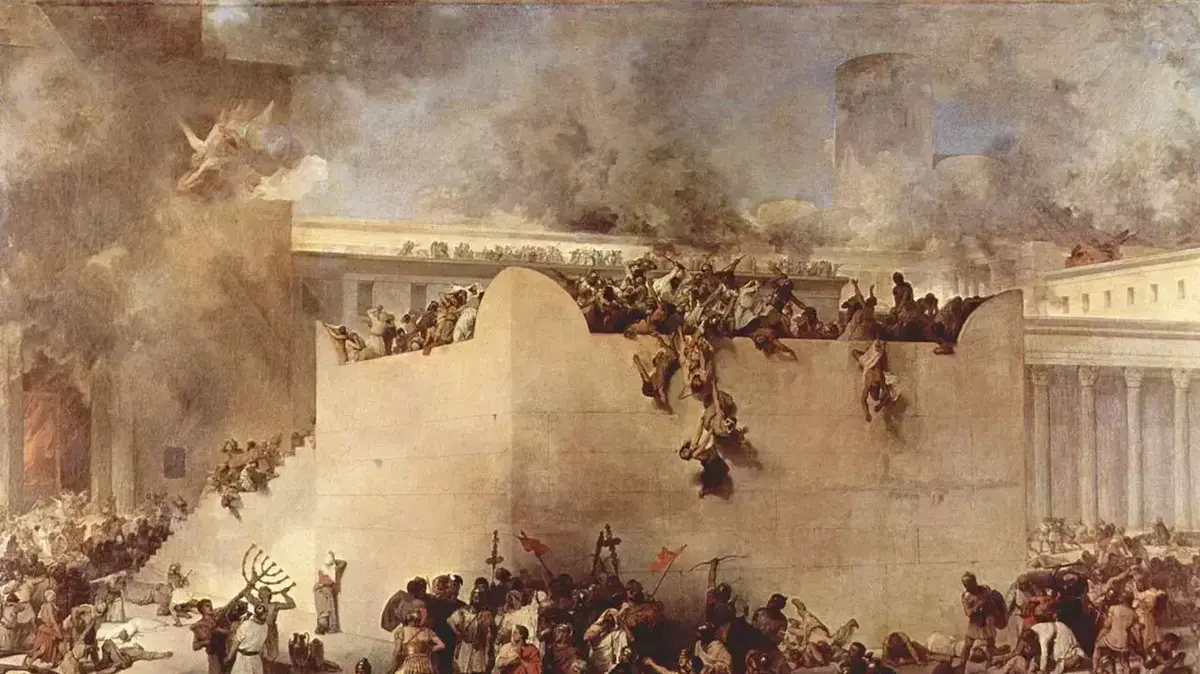Every Jerusalemite knows: Research has found the place where the destruction of the Second Temple began
A new study reveals archeological evidence of the intensity of the Roman attack and the location of the firing machines in the destruction of the Second Temple in an area familiar to every Jerusalemite - the Cats' Square in the Nechalat Sheva neighborhood.
The researcher, Kafir Arbiv, used a computer program for ballistic calculations from a 2000-year-old battlefield
Ziv Reinstein
07/08/2022
Sunday, 07 August 2022, 08:51 Updated: 09:15
Share on Facebook
Share on WhatsApp
Share on Twitter
Share by email
Share in general
Comments
Comments
The Last Battle for Jerusalem and the Destruction of the Second Temple (courtesy of the Magalim Institute of Beit Ir David)
On the occasion of Tisha B'Av, the Antiquities Authority publishes today (Sunday) the results of a new study, which sheds light on the strength of the Roman army and its points of entry into Jerusalem in the battles that led to the destruction of the Second Temple in the city.
"Today's Tisha B'av is the day when the Second Temple was destroyed," says archaeologist Kafir Arbiv, a researcher at the Antiquities Authority.
"The temple was destroyed after four months of siege and an intense battle led by the Romans led by Titus, with the aim of conquering the city and suppressing the great rebellion that the Jews started four years earlier. The Romans had a formidable, well-trained army, equipped with the best modern weapons of the time. This There was a brutal, unstoppable war machine."
According to the study, some of the artillery machines of the Roman army were stationed in the center of the city, in an area familiar to every Jerusalemite: 'Cat Square' in the Nechalat Sheva neighborhood.
Some of the artillery machines of the Roman army were located here.
Nachalat Sheva neighborhood, Jerusalem (Photo: Erez Michaeli)
The excavation site in the Russian lot.
On the ground are stones from Lystra, tangible evidence of the battle that ensued (Photo: Israel Antiquities Authority, Yuli Schwartz)
Buildings in Lystra that were launched from a sophisticated shooting machine at distances of up to 400 meters (Photo: Israel Antiquities Authority, Yuli Schwartz)
No evidence of giant siege rams was found
Arbiv systematically collected and documented Roman weapons of destruction found in Jerusalem excavations, many of which were discovered in an archaeological dig he conducted in the Russian lot, near the city hall building, together with Dr. Rina Avner. The arsenal of Roman weapons discovered so far included: hundreds of catapults of various sizes launched from a machine Sophisticated shooting at distances of 100-400 meters; small stone slingshots, which were operated by simple but trained soldiers and launched using rocket launchers; catapults - shooting machines that launched spears up to a range of 150-200 meters. Also found were spears, swords, arrowheads - including arrows Heavier than usual, armor-piercing.
"It is known from historical sources that the Roman army used huge siege rams that battered the walls and siege towers, with which they rushed to the walls, but no evidence of them has been found so far in Jerusalem," says Amit Ram, director of the Jerusalem Region at the Antiquities Authority.
Kafir Arbiv, the director of the excavation, cleans one of the sling stones (Photo: Israel Antiquities Authority, Yuli Schwartz)
Ballistae of different sizes found at the excavation site (Photo: Israel Antiquities Authority, Kfir Aviv)
Spearhead from the battle against Titus' army (Photo: Israel Antiquities Authority, Clara Amit)
The ballistic calculations included the launch angles of the stones
Arbiv's research from the Antiquities Authority focused on hundreds of catapult stones - the catapults.
The analysis of the stones of the catapults indicated different sizes and different weights of the stones - some of them were used against a person and launched towards the walls to prevent the Jewish rebels from rising above the line of the walls.
Others, the heavy ones - were thrown powerfully towards the walls in order to score.
According to Arbiv, "With the help of a computer program, I precisely positioned the stones of the found catapults. I took into account the topography of the area and the location of the walls of Jerusalem from the time of the Second Temple. I performed ballistic calculations, which include the throwing angles and the throwing distance of the stones. All these were crossed with the descriptions of the detailed of Josephus Flavius, aka Josephus ben Mattathias - the famous Jewish historian of the period, who details in his book 'The History of the Jewish War with the Romans' the course of the battle and the conquest and destruction of Jerusalem."
The study also points for the first time to the estimated point of entry of the Roman troops into the city.
In the excavation by Arbiv and Dr. Avner in the Russian field, a section of the "Third Wall" - the third line of fortification that surrounded the city - was discovered. At the foot of a certain point, an unusual concentration of catapult stones was discovered - some of them broken and shattered after hitting the wall. It is evident that towards the Roman army concentrated Effort at this point, and hundreds - even thousands of catapult stones, were directed towards the point. "It's not surprising, says Arbiv.
"This is a point that controls the space, and anyone who owns it, owns the fate of the city. This is also consistent with the descriptions of Josephus, who states that Titus ordered a breach into the city in the northwestern area of the wall."
tourism
news
Tags
Israel Antiquities Authority
The Temple Mount
the wall
T. Bav
Jerusalem

